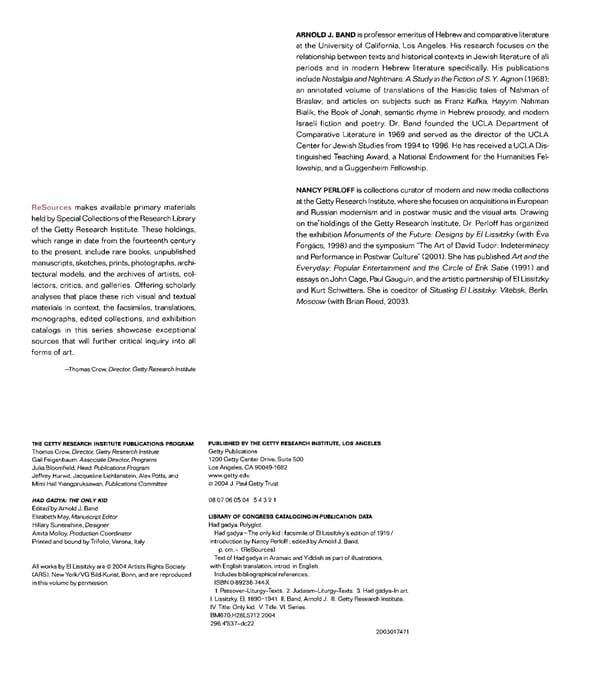ARNOLD J. BAND is professor emeritus of Hebrew and comparative literature at the University of California, Los Angeles. His research focuses on the relationship between texts and historical contexts in Jewish literature of all periods and in modern Hebrew literature specifically. His publications include Nostalgia and Nightmare: A Study in the Fiction of S. Y. Agnon (1968); an annotated volume of translations of the Hasidic tales of Nahman of Braslav; and articles on subjects such as Franz Kafka, Hayyim Nahman Bialik, the Book of Jonah, semantic rhyme in Hebrew prosody, and modern Israeli fiction and poetry. Dr. Band founded the UCLA Department of Comparative Literature in 1969 and served as the director of the UCLA Center for Jewish Studies from 1994 to 1996. He has received a UCLA Dis tinguished Teaching Award, a National Endowment for the Humanities Fel lowship, and a Guggenheim Fellowship. NANCY PERLOFF is collections curator of modern and new media collections at the Getty Research Institute, where she focuses on acquisitions in European ReSources makes available primary materials and Russian modernism and in postwar music and the visual arts. Drawing held by Special Collections of the Research Library on the'holdings of the Getty Research Institute, Dr. Perloff has organized of the Getty Research Institute. These holdings, the exhibition Monuments of the Future: Designs by El Lissitzky (with Eva which range in date from the fourteenth century Forgacs, 1998) and the symposium "The Art of David Tudor: Indeterminacy to the present, include rare books, unpublished and Performance in Postwar Culture" (2001). She has published Art and the manuscripts, sketches, prints, photographs, archi Everyday: Popular Entertainment and the Circle of Erik Satie (1991) and tectural models, and the archives of artists, col essays on John Cage, Paul Gauguin, and the artistic partnership of El Lissitzky lectors, critics, and galleries. Offering scholarly and Kurt Schwitters. She is coeditor of Situating El Lissitzky: Vitebsk, Berlin, analyses that place these rich visual and textual Moscow (with Brian Reed, 2003). materials in context, the facsimiles, translations, monographs, edited collections, and exhibition catalogs in this series showcase exceptional sources that will further critical inquiry into all forms of art. —Thomas Crow, Director, Getty Research Institute THE GETTY RESEARCH INSTITUTE PUBLICATIONS PROGRAM PUBLISHED BY THE GETTY RESEARCH INSTITUTE, LOS ANGELES Thomas Crow, Director, Getty Research Institute Getty Publications Gail Feigenbaum, Associate Director, Programs 1200 Getty Center Drive, Suite 500 Julia Bloomfield, Head, Publications Program Los Angeles, CA 900491682 Jeffrey Hurwit, Jacqueline Lichtenstein, Alex Potts, and www.getty.edu Mimi Hall Yiengpruksawan, Publications Committee © 2004 J. Paul Getty Trust HAD GADYA: THE ONLY KID 08 07 06 05 04 5 4 3 2 1 Edited'by Arnold J. Band Elizabeth May, Manuscript Editor LIBRARY OF CONGRESS CATALOGINGINPUBLICATION DATA Hillary Sunenshine, Designer Had gadya. Polyglot. Amita Molloy, Production Coordinator Had gadya = The only kid : facsimile of El Lissitzky's edition of 1919/ Printed and bound by Trifolio, Verona, Italy introduction by Nancy Perloff; edited by Arnold J. Band. p. cm. (ReSources) Text of Had gadya in Aramaic and Yiddish as part of illustrations, All works by El Lissitzky are © 2004 Artists Rights Society with English translation; introd. in English. (ARS), New York/VG BildKunst, Bonn, and are reproduced Includes bibliographical references, in this volume by permission. ISBN 089236744X 1. PassoverLiturgyTexts. 2. JudaismLiturgyTexts. 3. Had gadyaln art. I. Lissitzky, El, 18901941. II. Band, Arnold J. III. Getty Research Institute. IV. Title: Only kid. V. Title. VI. Series. BM670.H28L5712 2004 296.4'537dc22 2003017471
 Had Gadya The Only Kid: Lissitzky 1919 Page 3 Page 5
Had Gadya The Only Kid: Lissitzky 1919 Page 3 Page 5